Perpendicular Magnetization Behavior of Low- Temperature Ordered FePt Films with Insertion of Ag Nanolayers
Abstract
:1. Introduction
2. Experiments and Multilayer Film Structures
3. Results and Discussion
4. Conclusions
Acknowledgments
Conflicts of Interest
References
- Weller, D.; Moser, A.; Folks, L.; Best, M.E.; Lee, W.; Toney, M.F.; Schwickert, M.; Thiele, J.U.; Doerner, M.F. High Ku materials approach to 100 Gbits/in2. IEEE Trans. Magn. 2000, 36, 10–15. [Google Scholar] [CrossRef]
- Skomski, R. Nanomagnetics. J. Phys.: Condens. Matter 2003, 15, R841–R896. [Google Scholar] [CrossRef]
- Chappert, C.; Fert, A.; van Dau, F.N. The emergence of spin electronics in data storage. Nature Mater. 2007, 6, 813–823. [Google Scholar] [CrossRef] [PubMed]
- Seki, T.; Hasegawa, Y.; Mitani, S.; Takahashi, S.; Imamura, H.; Maekawa, S.; Nitta, J.; Takanashi, K. Giant spin Hall effect in perpendicularly spin-polarized FePt/Au devices. Nature Mater. 2008, 7, 125–129. [Google Scholar] [CrossRef] [PubMed]
- Matsumoto, S.; Shima, T. Magnetic properties of FePt thin films with multilayered structure. J. Phys. Conf. Ser. 2011, 266, 012038:1–012038:5. [Google Scholar] [CrossRef]
- Ho, P.; Han, G.C.; Chow, G.M.; Chen, J.S. Interlayer magnetic coupling in perpendicular anisotropy L10-FePt based pseudo spin valve. Appl. Phys. Lett. 2011, 98, 252503:1–252503:3. [Google Scholar]
- Seki, T.; Hotta, K.; Imamura, H.; Nozaki, Y.; Takanashi, K. Characteristic field angular dependence of magnetization switching assisted by spin wave excitation. Appl. Phys. Lett. 2013, 103, 122403:1–122403:4. [Google Scholar] [CrossRef]
- Seki, T.; Utsumiya, K.; Nozaki, Y.; Imamura, H.; Takanashi, K. Spin wave-assisted reduction in switching field of highly coercive iron-platinum magnets. Nature Commun. 2013, 4, 1726:1–1726:6. [Google Scholar] [CrossRef] [PubMed]
- Pal, S.; Barman, S.; Hellwig, O.; Barman, A. Effect of the spin-twist structure on the spin-wave dynamics in Fe55Pt45/Ni80Fe20 exchange coupled bi-layers with varying Ni80Fe20 thickness. J. Appl. Phys. 2014, 115, 17D105:1–17D105:3. [Google Scholar] [CrossRef]
- Hussain, S.; Bhatia, C.S.; Yang, H.; Danner, A.J. Effect of FePt on resonant behaviour of a near field transducer for high areal density heat assisted magnetic recording. Appl. Phys. Lett. 2014, 104, 111107:1–111107:3. [Google Scholar] [CrossRef]
- Seki, T.; Yako, H.; Yamamoto, T.; Kubota, T.; Sakuraba, Y.; Ueda, M.; Takanashi, K. Spin torque-induced magnetization dynamics in giant magnetoresistance devices with Heusler alloy layers. J. Phys. D: Appl. Phys. 2015, 48, 164010:1–164010:8. [Google Scholar] [CrossRef]
- Luo, C.P.; Liou, S.H.; Gao, L.; Liu, Y.; Sellmyer, D.J. Nanostructured FePt:B2O3 thin films with perpendicular magnetic anisotropy. Appl. Phys. Lett. 2000, 77, 2225–2227. [Google Scholar] [CrossRef]
- Hsu, Y.N.; Jeong, S.; Laughlin, D.E.; Lambeth, D.N. Effects of Ag underlayers on the microstructure and magnetic properties of epitaxial FePt thin films. J. Appl. Phys. 2001, 89, 7068–7070. [Google Scholar] [CrossRef]
- Zhang, Z.G.; Kang, K.; Suzuki, T. FePt (001) texture development on an Fe–Ta–C magnetic soft underlayer with SiO2/MgO as an intermediate layer. Appl. Phys. Lett. 2003, 83, 1785–1787. [Google Scholar] [CrossRef]
- Kang, K.; Zhang, Z.G.; Papusoi, C.; Suzuki, T. Composite nanogranular films of FePt-MgO with (001) orientation onto glass substrates. Appl. Phys. Lett. 2004, 84, 404–406. [Google Scholar] [CrossRef]
- Peng, Y.; Zhu, J.G.; Laughlin, D.E. L10 FePt–MgO perpendicular thin film deposited by alternating sputtering at elevated temperature. J. Appl. Phys. 2006, 99, 08F907:1–08F907:3. [Google Scholar] [CrossRef]
- Li, B.H.; Feng, C.; Gao, X.; Teng, J.; Yu, G.H.; Xing, X.; Liu, Z.Y. Magnetic properties and microstructure of FePt/BN nanocomposite films with perpendicular magnetic anisotropy. Appl. Phys. Lett. 2007, 91, 152502:1–152502:3. [Google Scholar] [CrossRef]
- Wei, D.H.; Yuan, F.T.; Chang, H.W.; Yao, Y.D. Effects of Pt and Fe underlayers on the microstructure and magnetization reversal of epitaxial FePt films for high areal density magnetic recording. J. Appl. Phys. 2008, 103, 07E138:1–07E138:3. [Google Scholar] [CrossRef]
- Feng, C.; Zhan, Q.; Li, B.H.; Teng, J.; Li, M.H.; Jiang, Y.; Yu, G.H. Magnetic properties and microstructure of FePt/Au multilayers with high perpendicular magnetocrystalline anisotropy. Appl. Phys. Lett. 2008, 93, 152513:1–152513:3. [Google Scholar] [CrossRef]
- Wei, D.H.; Yao, Y.D. Controlling microstructure and magnetization process of FePd (001) films by staged thermal modification. Appl. Phys. Lett. 2009, 95, 172503:1–172503:3. [Google Scholar] [CrossRef]
- Wei, D.H. Magnetic assembles of FePt (001) nanoparticles with SiO2 addition. J. Appl. Phys. 2009, 105, 07A715:1–07A715:3. [Google Scholar] [CrossRef]
- Kent, A.D. Spintronics: Perpendicular all the way. Nature Mater. 2010, 9, 699–700. [Google Scholar] [CrossRef] [PubMed]
- Ohsugi, R.; Kohda, M.; Seki, T.; Ohtsu, A.; Mizuguchi, M.; Takanashi, K.; Nitta, J. MgO layer thickness dependence of structure and magnetic properties of L10-FePt/MgO/GaAs structures. Jpn. J. Appl. Phys. 2012, 51, 02BM05:1–02BM05:4. [Google Scholar] [CrossRef]
- Cuadrado, R.; Chantrell, R.W. Interaction potential of FePt with the MgO(001) surface. Phys. Rev. B 2015, 91, 075420:1–075420:9. [Google Scholar] [CrossRef]
- Speliotis, Th.; Varvaro, G.; Testa, A.M.; Giannopoulos, G.; Agostinelli, E.; Li, W.; Hadjipanayis, G.; Niarchos, D. Microstructure and magnetic properties of (001) textured L10 FePt films on amorphous glass substrate. Appl. Surf. Sci. 2015, 337, 118–124. [Google Scholar] [CrossRef]
- Endo, Y.; Kikuchi, N.; Kitakami, O.; Shimada, Y. Lowering of ordering temperature for fct Fe–Pt in Fe/Pt multilayers. J. Appl. Phys. 2001, 89, 7065–7067. [Google Scholar] [CrossRef]
- Shima, T.; Moriguchi, T.; Mitani, S.; Takanashi, K. Low-temperature fabrication of L10 ordered FePt alloy by alternate monatomic layer deposition. Appl. Phys. Lett. 2002, 80, 288–290. [Google Scholar] [CrossRef]
- Chou, S.C.; Yu, C.C.; Liou, Y.; Yao, Y.D.; Wei, D.H.; Chin, T.S.; Tai, M.F. Annealing effect on the Fe/Pt multilayers grown on Al2O3 (0001) substrates. J. Appl. Phys. 2004, 95, 7276–7278. [Google Scholar] [CrossRef]
- Yao, B.; Coffey, K.R. The effective interdiffusivity, structure, and magnetic properties of [Fe/Pt]n multilayer films. J. Appl. Phys. 2008, 103, 07E107:1–07E107:3. [Google Scholar] [CrossRef]
- Yao, B.; Coffey, K.R. Quantification of L10 phase volume fraction in annealed [Fe/Pt]n multilayer films. J. Appl. Phys. 2009, 105, 033901:1–033901:8. [Google Scholar] [CrossRef]
- Tanaka, M.; Ogata, Y.; Nakagawa, S. FePt films 2 nanometers thick with (001) preferential orientation on a MgO underlayer. J. Appl. Phys. 2011, 109, 07B716:1–07B716:3. [Google Scholar] [CrossRef]
- Wei, D.H.; Chi, P.W.; Chao, C.H. Perpendicular magnetization reversal mechanism of functional FePt films for magnetic storage medium. Jpn. J. Appl. Phys. 2014, 53, 11RG01:1–11RG01:5. [Google Scholar] [CrossRef]
- Hsu, Y.N.; Jeong, S.; Laughlin, D.E.; Lambeth, D.N. The effects of Ag underlayer and Pt intermediate layers on the microstructure and magnetic properties of epitaxial FePt thin films. J. Magn. Magn. Mater. 2003, 260, 282–294. [Google Scholar] [CrossRef]
- Zhao, Z.L.; Ding, J.; Inaba, K.; Chen, J.S.; Wang, J.P. Promotion of L10 ordered phase transformation by the Ag top layer on FePt thin films. Appl. Phys. Lett. 2003, 83, 2196–2198. [Google Scholar] [CrossRef]
- Shao, Y.; Yan, M.L.; Sellmyer, D.J. Effects of rapid thermal annealing on nanostructure, texture and magnetic properties of granular FePt:Ag films for perpendicular recording. J. Appl. Phys. 2003, 93, 8152–8154. [Google Scholar] [CrossRef]
- Chen, J.S.; Hu, J.F.; Lim, B.C.; Phyoe, W.L.; Liu, B.; Ju, G. Structure and magnetic properties of L10 FePt film with Ag heat sink layer. J. Appl. Phys. 2009, 105, 07B724:1–07B724:3. [Google Scholar]
- Tsai, J.L.; Tzeng, H.T.; Lin, G.B.; Liu, B.F. The Ag effect on magnetic properties and microstructure of FePt/Ag2Te particulate films. J. Alloy Compd. 2010, 502, 456–460. [Google Scholar] [CrossRef]
- Wen, W.C.; Chepulskii, R.V.; Wang, L.W.; Curtarolo, S.; Lai, C.H. Accelerating disorder–order transitions of FePt by performing a metastable AgPt phase. Acta Mater. 2012, 60, 7258–7264. [Google Scholar] [CrossRef]
- Katona, G.L.; Vladymyrskyi, I.A.; Makogon, I.M.; Sidorenko, S.I.; Kristály, F.; Daróczi, L.; Csik, A.; Liebig, A.; Beddies, G.; Albrecht, M.; et al. Grain boundary diffusion induced reaction layer formation in Fe/Pt thin films. Appl. Phys. A 2013, 115, 203–211. [Google Scholar] [CrossRef]
- Crisan, A.D.; Vasiliu, F.; Mercioniu, I.; Crisan, O. Role of Ag addition in L10 ordering of FePt-based nanocomposite magnets. Philosoph. Mag. 2014, 94, 174–189. [Google Scholar] [CrossRef]
- Varaprasad, B.S.D.Ch.S.; Takahashi, Y.K.; Wang, J.; Ina, T.; Nakamura, T.; Ueno, W.; Nitta, K.; Uruga, T.; Hono, K. Mechanism of coercivity enhancement by Ag addition in FePt-C granular films for heat assisted magnetic recording media. Appl. Phys. Lett. 2014, 104, 222403:1–222403:4. [Google Scholar] [CrossRef]
- Kang, K.; Zhang, Z.G.; Papusoi, C.; Suzuki, T. (001) oriented FePt–Ag composite nanogranular films on amorphous substrate. Appl. Phys. Lett. 2003, 82, 3284–3286. [Google Scholar] [CrossRef]
- Wan, J.; Huang, Y.; Zhang, Y.; Bonder, M.J.; Hadjipanayis, G.C.; Weller, D. Particulate FePt/Ag(C) films with strong perpendicular anisotropy. J. Appl. Phys. 2005, 97, 10J121:1–10J121:3. [Google Scholar] [CrossRef]
- Zhao, Z.L.; Chen, J.S.; Ding, J.; Yi, J.B.; Liu, B.H.; Wang, J.P. Fabrication and microstructure of high coercivity FePt thin films at 400 °C. Appl. Phys. Lett. 2006, 88, 052503:1–052503:3. [Google Scholar] [CrossRef]
- Li, B.H.; Feng, C.; Yang, T.; Hwang, P.; Teng, J.; Yu, G.H.; Zhu, F.W. Approach to enhance the coercivity in perpendicular FePt/Ag nanoparticle film. J. Appl. Phys. 2006, 99, 016102:1–016102:3. [Google Scholar] [CrossRef]
- Chen, J.S.; Zhou, Y.Z.; Sun, C.J.; Han, S.W.; Chow, G.M. Where is the Ag in FePt-Ag composited films? Appl. Phys. Lett. 2011, 98, 131914:1–131914:3. [Google Scholar] [CrossRef]
- Takahashi, Y.K.; Hono, K.; Shima, T.; Takanashi, K. Microstructure and magnetic properties of FePt thin films epitaxially grown on MgO (001) substrates. J. Magn. Magn. Mater. 2003, 267, 248–255. [Google Scholar] [CrossRef]
- Liu, M.; Jin, T.; Hao, L.; Cao, J.; Wang, Y.; Wu, D.; Bai, J.; Wei, F. Effects of Ru and Ag cap layers on microstructure and magnetic properties of FePt ultrathin films. Nanoscale Res. Lett. 2015, 10, 161:1–161:8. [Google Scholar] [CrossRef] [PubMed]
- Wohlfarth, E.P. The coefficient of magnetic viscosity. J. Phys. F: Met. Phys. 1984, 14, L155–L159. [Google Scholar] [CrossRef]
- Gau, J.S.; Brucker, C.F. Angular variation of the coercivity in magnetic recording thin films. J. Appl. Phys. 1985, 57, 3988–3990. [Google Scholar] [CrossRef]
- Byun, C.; Sivertsen, J.M.; Judy, J.H. A study on magnetization reversal mechanisms of CoCr films. IEEE Trans. Magn. 1986, 22, 1155–1157. [Google Scholar] [CrossRef]
- Suzuki, T.; Honda, N.; Ouchi, K. Magnetization reversal process in polycrystalline ordered Fe–Pt(001) thin films. J. Appl. Phys. 1999, 85, 4301–4303. [Google Scholar] [CrossRef]
- Coffey, K.R.; Thomson, T.; Thiele, J.U. Angle dependent magnetization reversal of thin film magnetic recording media. J. Appl. Phys. 2003, 93, 8471–8473. [Google Scholar] [CrossRef]
- Ma, Y.G.; Yang, Z.; Matsumoto, M.; Morisako, A.; Takei, S. Structural and magnetic properties of NdFeB thin films sputtered on W underlayers. J. Magn. Magn. Mater. 2003, 267, 341–346. [Google Scholar] [CrossRef]
- Liu, X.X.; Ishida, G.; Morisako, A. Magnetization reversal mechanism of Nd–Fe–B films with perpendicular magnetic anisotropy. J. Appl. Phys. 2011, 109, 07A725:1–07A725:3. [Google Scholar] [CrossRef]
- Kelly, P.E.; O’Grady, K.; Mayo, P.I.; Chantrell, R.W. Switching mechanisms in cobalt-phosphorus thin films. IEEE Trans. Magn. 1989, 25, 3881–3883. [Google Scholar] [CrossRef]
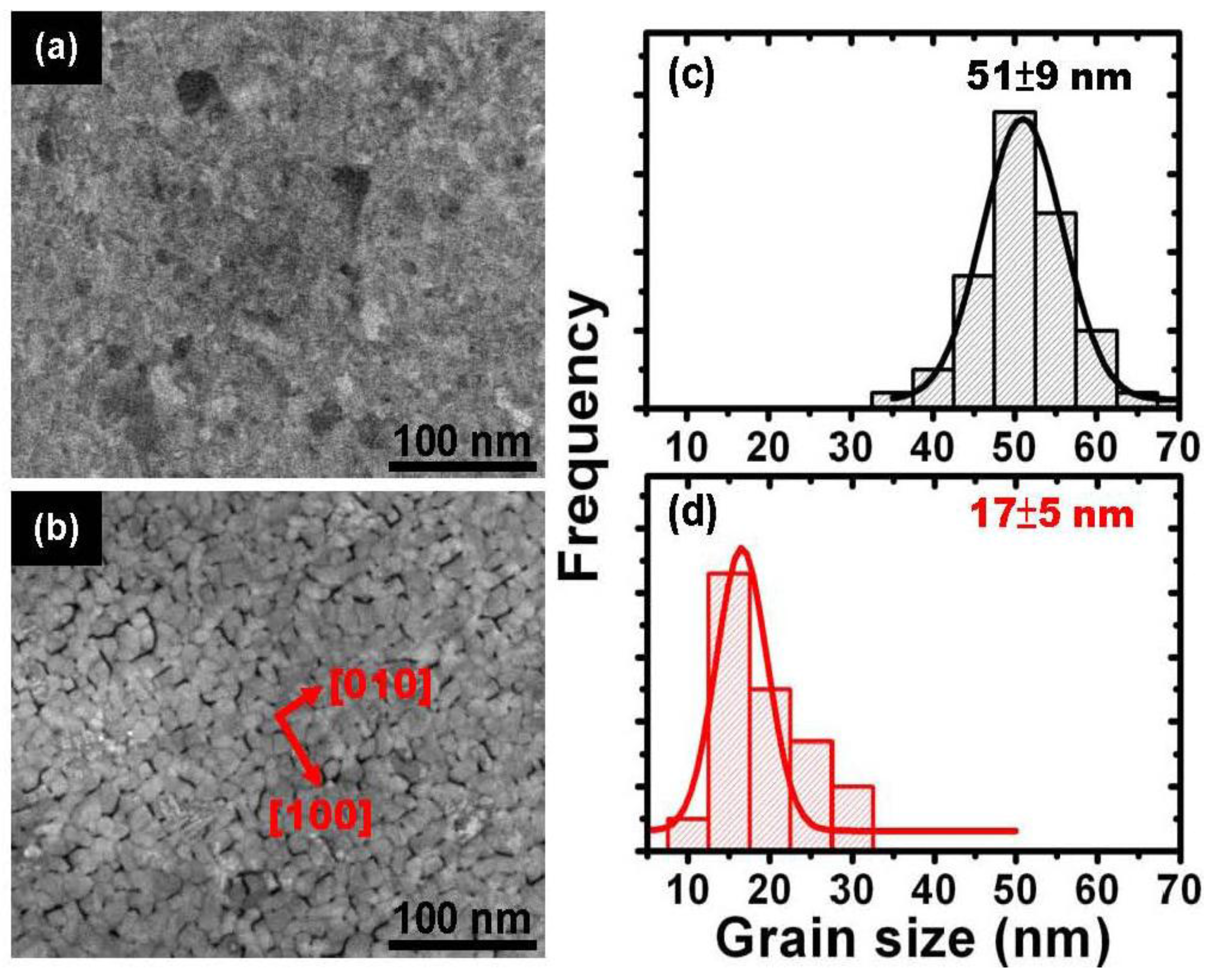
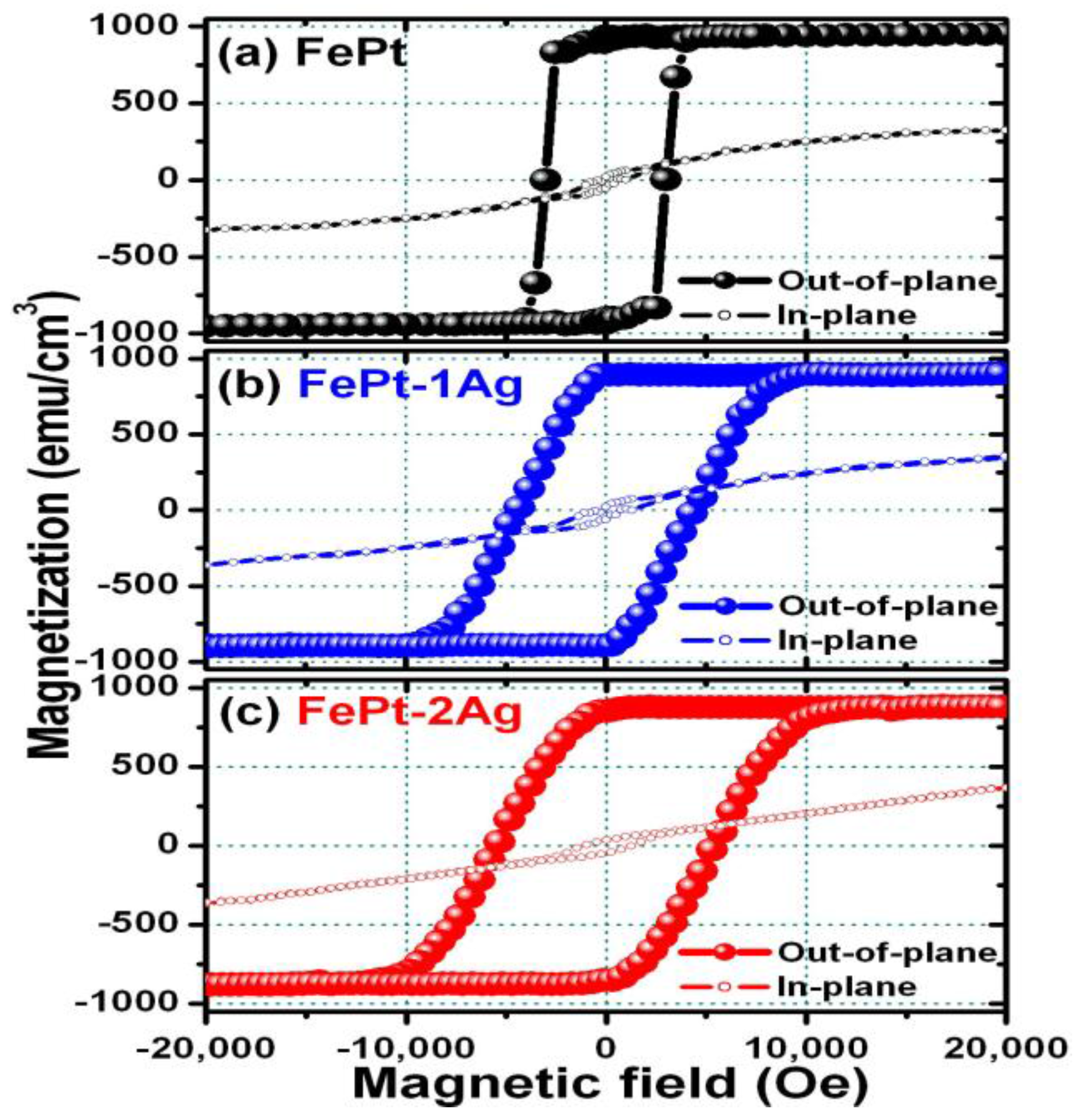
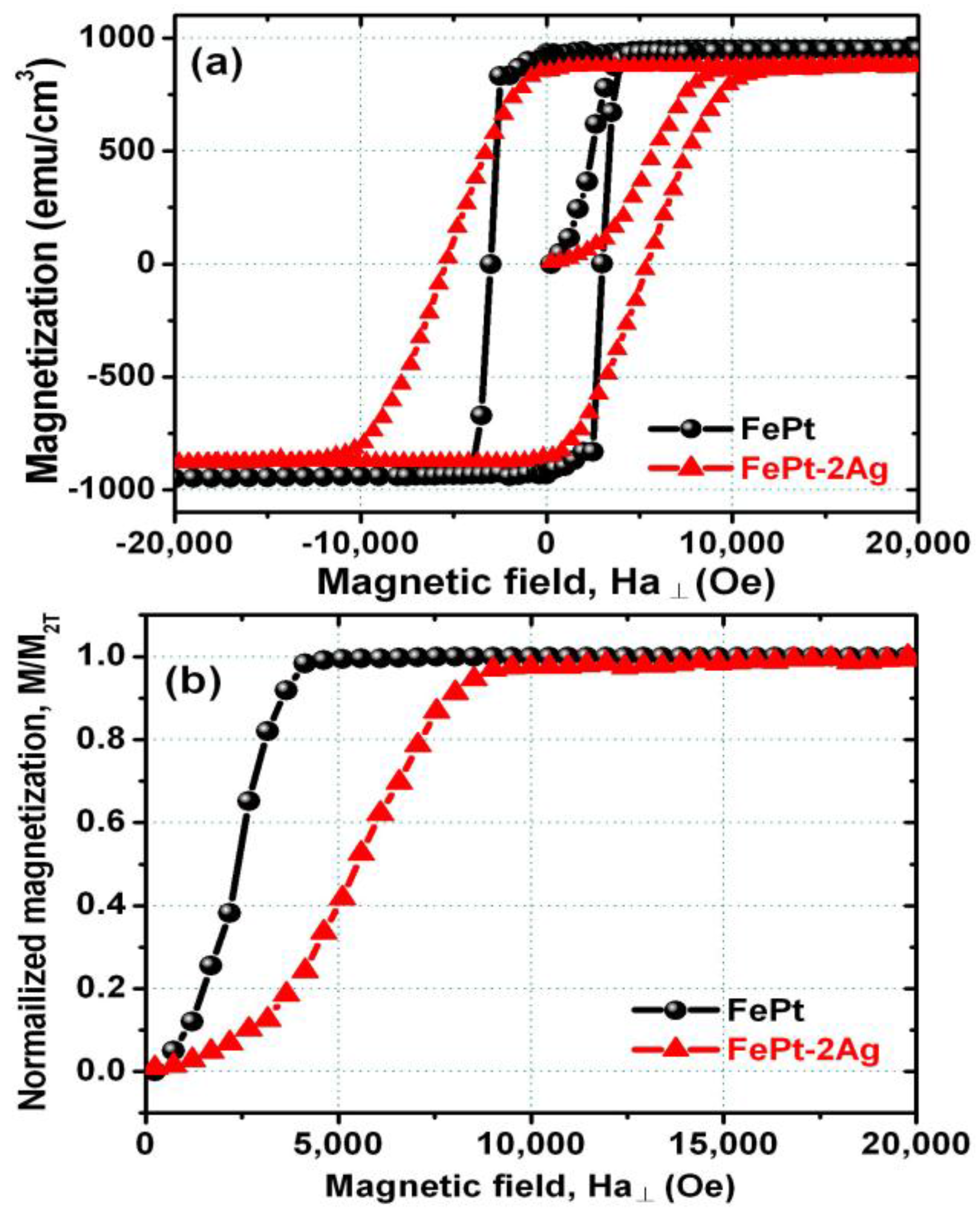
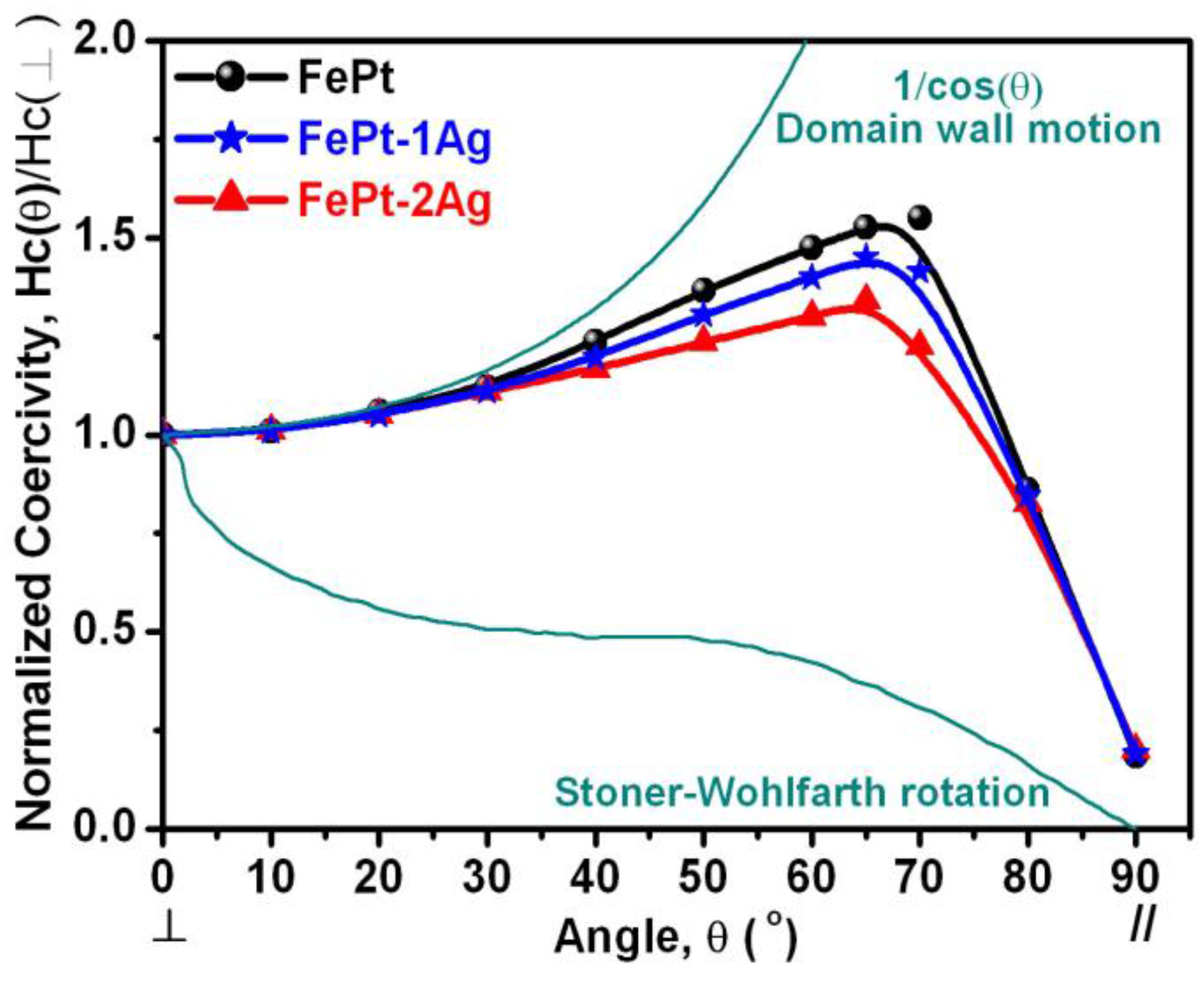
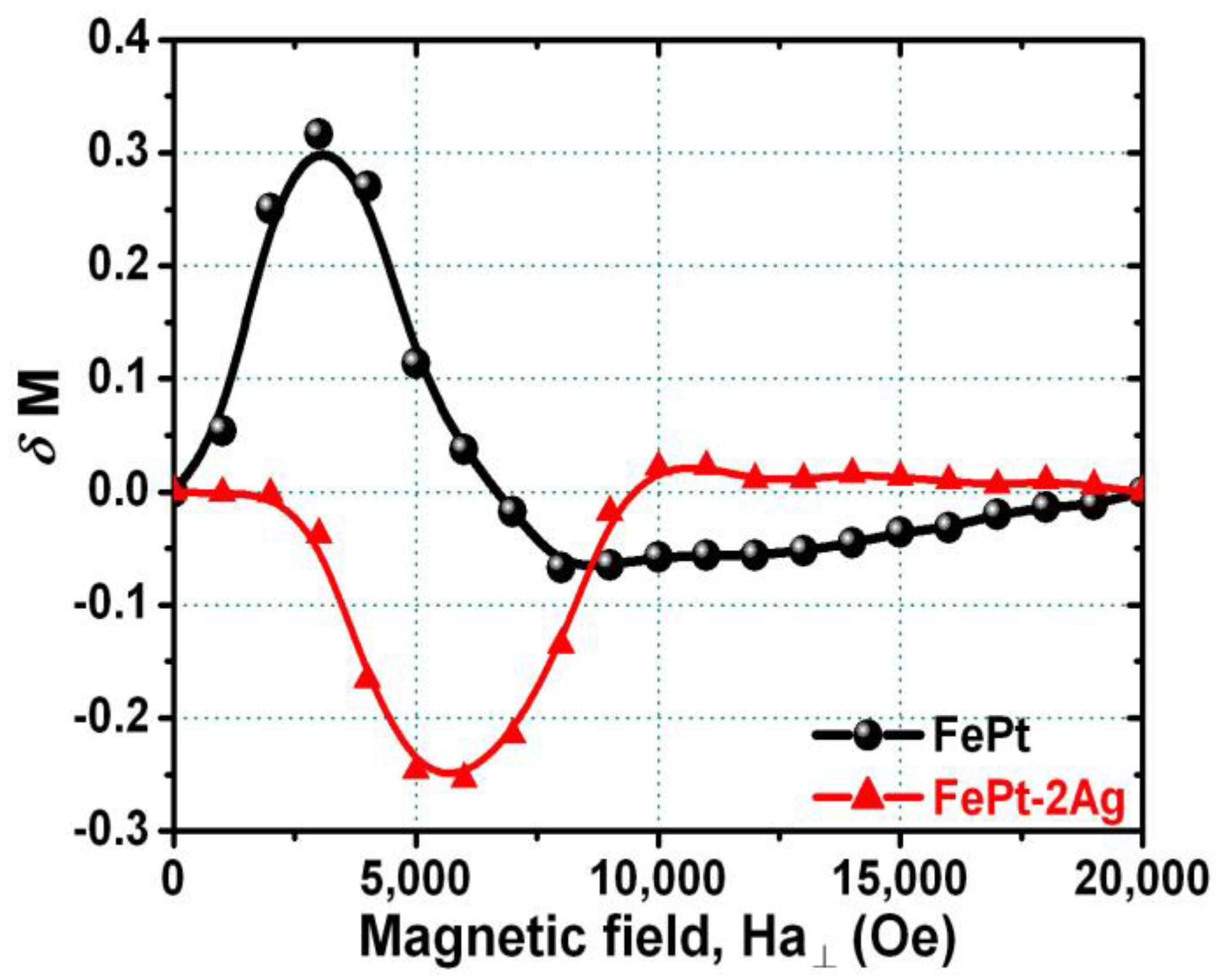

| Structures (Denoted) | Film Structures (Thickness nm) | Hc﬩ (Oe) | Ms﬩ (emu/m3) | Mr﬩ (emu/m3) | Mr﬩/Ms﬩ (ratio) | Ku (erg/m3) |
|---|---|---|---|---|---|---|
| FePt | [Fe/Pt]18 | 2998 | 950 | 932 | 0.98 | 2.5 × 107 |
| FePt–1Ag | [Fe/Pt]9/Ag0.5/[Fe/Pt]9 | 4220 | 900 | 876 | 0.97 | 2.3 × 107 |
| FePt–2Ag | [Fe/Pt]6/Ag0.5/[Fe/Pt]6/Ag0.5/[Fe/Pt]6 | 5264 | 875 | 835 | 0.95 | 2.1 × 107 |
© 2016 by the author; licensee MDPI, Basel, Switzerland. This article is an open access article distributed under the terms and conditions of the Creative Commons by Attribution (CC-BY) license (http://creativecommons.org/licenses/by/4.0/).
Share and Cite
Wei, D.-H. Perpendicular Magnetization Behavior of Low- Temperature Ordered FePt Films with Insertion of Ag Nanolayers. Materials 2016, 9, 209. https://doi.org/10.3390/ma9030209
Wei D-H. Perpendicular Magnetization Behavior of Low- Temperature Ordered FePt Films with Insertion of Ag Nanolayers. Materials. 2016; 9(3):209. https://doi.org/10.3390/ma9030209
Chicago/Turabian StyleWei, Da-Hua. 2016. "Perpendicular Magnetization Behavior of Low- Temperature Ordered FePt Films with Insertion of Ag Nanolayers" Materials 9, no. 3: 209. https://doi.org/10.3390/ma9030209






